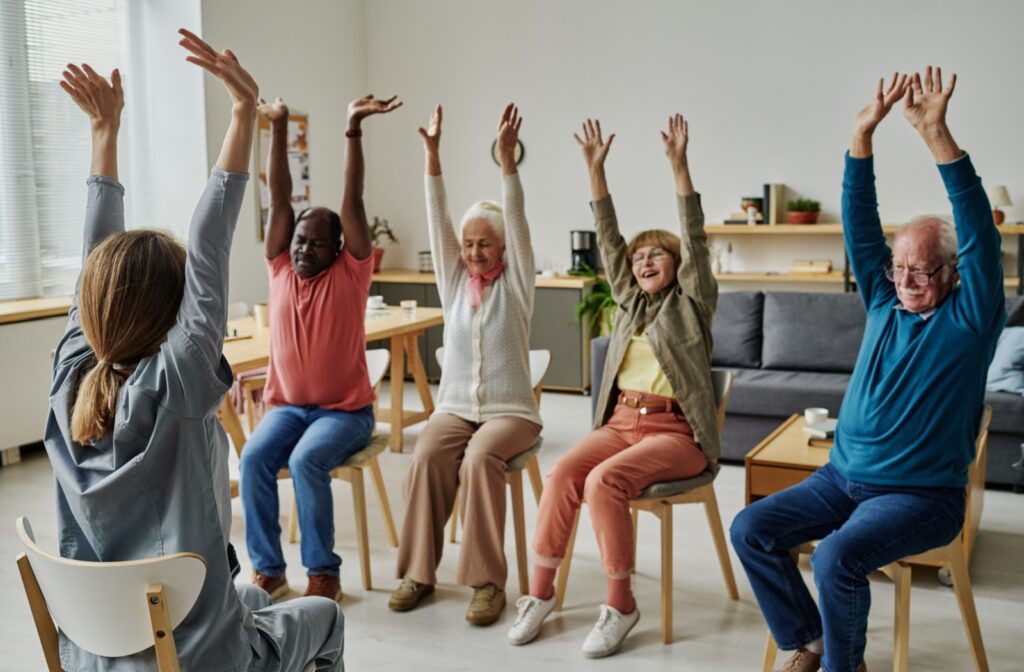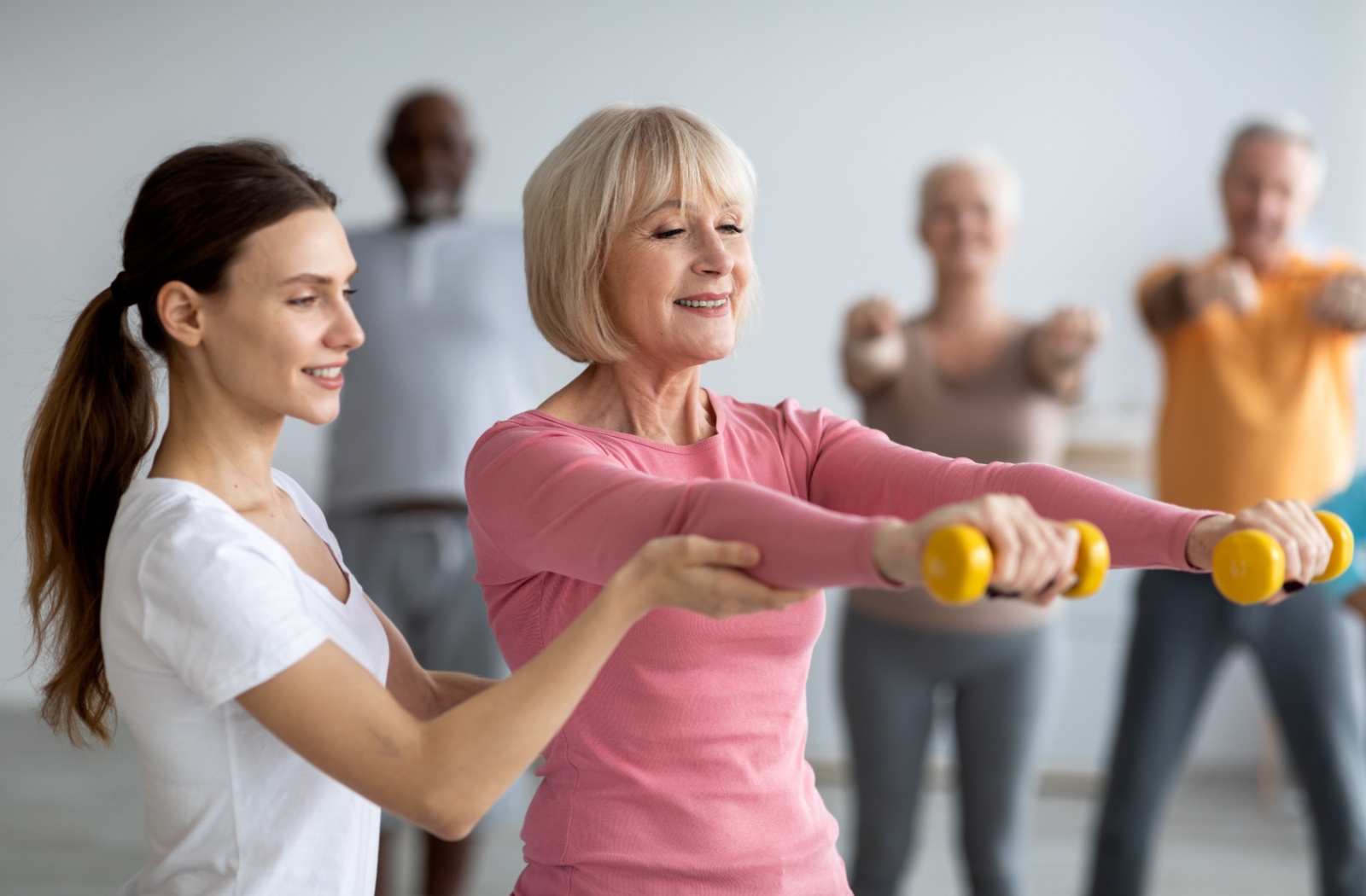Movement is medicine, and staying active as we grow older is one of the greatest ways to maintain health, independence, and overall quality of life.
The best kind of exercise is the one you enjoy. Not only does it make it easier to stay consistent, but it also helps you find joy in movement.
As a general rule, older adults should focus on three major kinds of exercises, each targeting different muscle groups for a well-rounded routine. These include:
- Aerobic activity such as dancing, swimming, walking, or gardening
- Strength training such as bodyweights, barre, or pilates
- Balance exercises like single-leg stands, tai chi, or yoga
Exercise shouldn’t feel like a chore but a beautiful way to take intentional time to support your overall wellness. Our complementary Stronger Living Program offers a personalized approach to wellness and is here to guide you on this journey to a stronger you.
Aerobic Physical Activity for Older Adults
Aerobic exercises–better known as cardio–are activities that support your heart and lung health by increasing your heart rate and oxygen intake.
Regular cardio reduces the risk of chronic diseases like heart disease and diabetes. Plus, it’s a natural mood booster, thanks to those feel-good endorphins your body releases during exercise.
Older adults should aim for at least 150 minutes of moderate-intensity or 75 minutes of vigorous aerobic activity weekly. It may sound overwhelming at first, but it feels more manageable when you break these numbers down into smaller increments.
For instance, 30 minutes of brisk walking or jogging 5 times a week, or 25 minutes of running or swimming 3 times a week, depending on your desired intensity.
No matter how you choose to break this down, what’s important is staying consistent. Regular aerobic activity keeps your heart pumping efficiently, maintains lung function, and improves circulation.
Examples of Aerobic Activity
Cardio doesn’t have to be intense or intimidating. You can modify your workout to fit your strength level and mobility. Start slowly and gradually increase the intensity as your stamina builds!
Some great aerobic activities for older adults include:
- Walking: A daily walk around the neighborhood or park is low-impact and can be adjusted to your pace.
- Swimming: Gentle on the joints, swimming or water aerobics are great choices for those with arthritis or mobility issues.
- Cycling: Biking outside or on a stationary bike can be a fantastic, low-impact option.
- Dance classes: Line dancing, Zumba, or ballroom dancing are fun options that improve coordination while keeping your heart rate up.
For people seeking a greater challenge, vigorous-intensity activities require more effort, resulting in heavier breathing and more sweating than moderately intense activity.
The “talk test” is a helpful way to gauge the intensity of your workout. During vigorous activity, it becomes harder to talk. You may only manage to say a few words before needing to pause and catch your breath.
Strength Training for Older Adults
Strength training focuses on building muscle mass and bone density using resistance. Even if you’re not aiming for bodybuilder status, regular strength-building helps counteract this natural muscle loss and decline in bone density.
Strong muscles support your joints, improve posture, and make daily activities much easier, like lifting groceries or standing up from a chair. Plus, strength training helps engage your large muscle groups, helping to reduce your risk of falls and improve overall balance.
In addition to aerobic activities of your choice, experts recommend strength training at least two days a week, targeting all major muscle groups.

Examples of Strength Training Activities
Not all strength training requires heavy weights! Plenty of beginner-friendly options can be easily modified based on energy levels, strength, and mobility. Here are a few to try:
- Bodyweight exercises: Push-ups against a wall, sit-to-stand exercises, or heel raises are great starting points.
- Barre and Pilates: These low-impact workouts improve flexibility and strength using controlled, precise movements, light weights, and resistance.
- Free weights: Light hand weights (or even canned goods) can help you complete bicep curls or shoulder presses.
- Full-body workouts: Look for circuit-style classes or routines that combine multiple strength exercises into one session.
The beauty of strength training lies in its adaptability. Depending on your mobility or energy, you can use props like chairs and medicine balls or modify these exercises to feel your muscles working without compromising your overall wellness.
Balance Exercises for Older Adults
Balance exercises help improve stability and coordination, reducing the risk of falls, which is a major concern for older adults. It may sound simple, but these exercises work the muscles around your core, legs, and ankles, helping you stay steady on your feet.
Improved balance goes beyond physical safety. It builds confidence, makes walking smoother, and allows you to enjoy an active lifestyle without feeling limited.
For a well-rounded routine, include at least one type of balance activity in your weekly schedule. Practicing balance complements the rest of your fitness routine.
Examples of Balance Exercises
Here are some effective balance exercises to incorporate seamlessly into your routine:
- Single-leg stands: Hold onto a sturdy chair and lift one leg off the ground for a few seconds. Switch sides and repeat.
- Tai chi: This practice focuses on slow, flowing movements that build balance and coordination while reducing stress.
- Yoga: A practice that encourages mind-body connections and incorporates balancing poses that strengthen your muscles while promoting flexibility.
- Seated balance exercises: If standing exercises feel too challenging, try shifting your weight side to side while seated on a stability ball or firm surface.
You can modify these to fit your comfort level. Don’t be afraid to use a steady surface, like a chair or wall, for support until your balance improves.
Practicing balance doesn’t have to be strenuous. Taking even a few minutes out of your day to balance on one foot while brushing your teeth is a great way to start incorporating this movement into your daily life.
Step Into a Stronger You
Regular physical activity offers a sustainable pathway to better health that can last well into your golden years. Start small, stay consistent, and enjoy your journey to physical wellness. Our Stronger Living Program at All American Assisted Living at Hanson can help you achieve your fitness goals. Connect with our team to learn more.





